Lewin Benjamin (ed.) Genes IX
Подождите немного. Документ загружается.

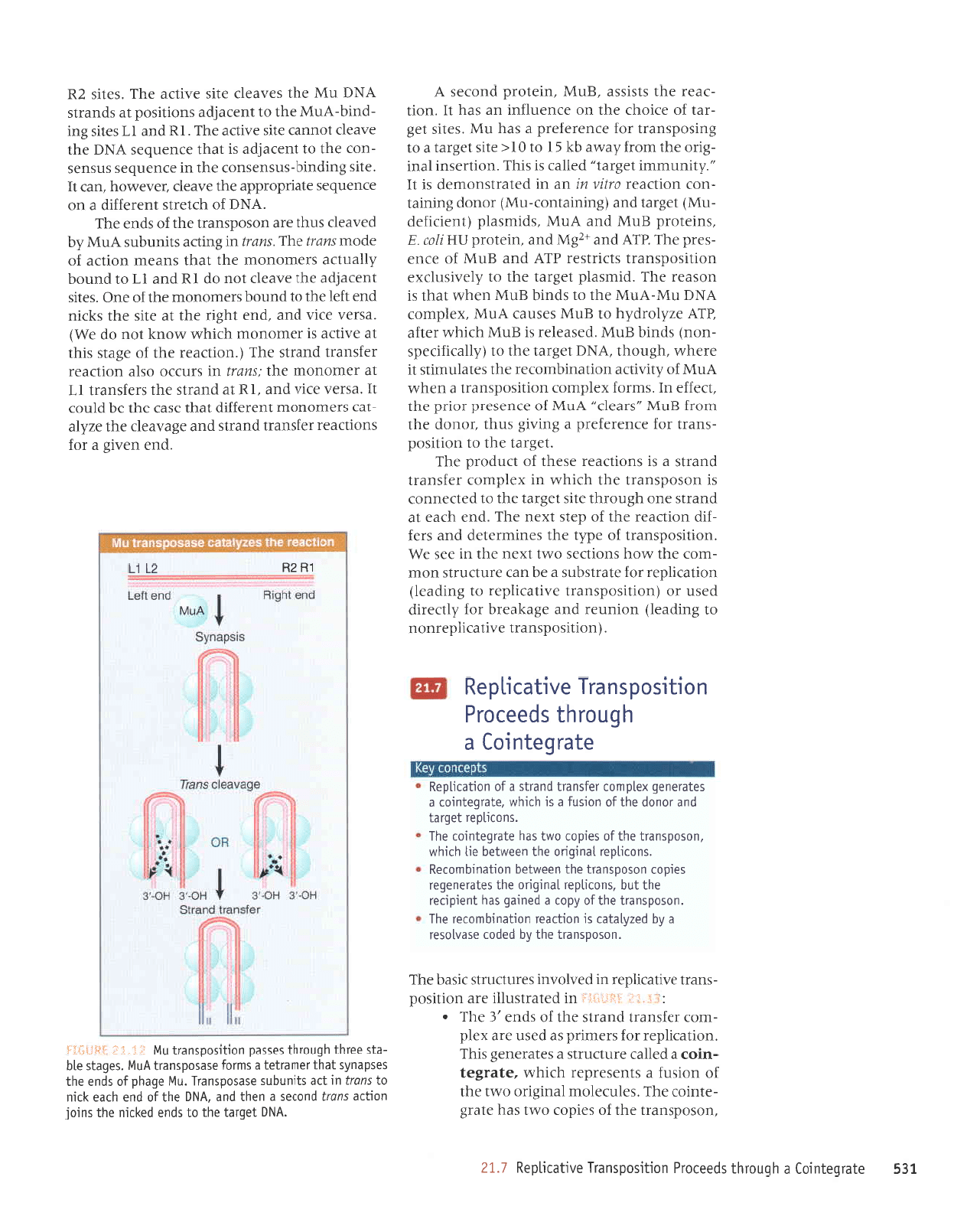
I€9
alprbalurol
e
qOnolql
spealotd
uolllsodsuell
a^qelrldaU
/'IZ
'uosodsueJt
eqt
Jo
sJrdoJ o^l.t seq Jter8
-Jluro)
Jql
'sJlnJJlor.u
[pulSrJo
o^^l Jq
I
Jo
uorsnJ e
stuJsJJder
qJIqM
'aletBa!
-uloJ
p
pJ[[p)
JJntJnrts e sateraua8 srql
'uor1er11dar
roy srarurrd
se
pesn
are
xald
-ruoJ
rJJsueJl
puerls
Jril
Jo
spuJ
,€
eHJ
.
:,r
:.
.1-r
.iijiiillj
UI
pJlPllsnlll
JJP uOIIISOd
-supJl
J^rleJrldar ur
panlo^ur
ssJnDnJls rrseq
JqI
'uosodsuerl
aq1
l{q papor
ose^losal
e
riq pazfleler
sr uorlleal uorlpurquJorel aqI
'uosodsuerl
aq1
1o
fdor e
paurpb
seq
lueLdLrar
eql
lnq
'suorrldar
leuLbuo
eq1 saleraua6er
sardol
uosodsupll oql uao/v\laq uorlpurquolau
'suorrldar
leur6uo
aql uaaMlaq orl
qrrqm
'uosodsuerl
aq1;o serdor oMl seq eler6eluror aql
'suorqdar
1abre1
pup
rouop
aql
jo
uorsnJ e sr
qlrLlM
'a1er6a1uLor
e
salereuab xelduror
ra;supll
puplls
p
1o
uoLlerqdeX
aler6alulol
P
qbnolql
spaalord
u ot
lrsodsu
PJI a^rlPl
rldau
'
(uorlrsodsuert
anrlerlldJJuou
or 8upea1) uorunJJ
pue
a8elearq
roy
.dlnartp
pJSn
ro
(uolllsodsuerl
azrrtelldar
o1 Surpeal)
uorlerrldar JoJ JleJlsqns
p
Jq ueJ JJnlJnJls
uour
-ruoJ
aql
Moq
suorlf,Js o.&tl
lxJu
eql
ur aas
JM
'uorlrsodsuerl
;o
adLl eq] seururrJlap
pue
sJJJ
-Jrp
uortJeeJ aqt;o dals
txJu
JqJ
'pua
qlpe
te
pueJts
auo
q8norqt
Jlls
tJBJpl
Jr{t ot
pJlJJuuo)
st uosodsuBJl
Jql
qJrqM
ur
xaldruor JaJSueJl
pupJls
e sr suorl)pJr JSJLIt
;o
t:npo.rd
aq1
'la8rel
aqt ot
uorltsod
-suerl
JoJ aruara;ard B
3ur.r.r8
snql
'rouop
Jql
uorJ
gnw
,,sJeelJ,. VnW
Jo
aluasard
rorrd aql
'lJaJJJ
uI
'sruJoJ
xalduor uorlrsodsuerl
e ueqM
VnW
Jo
Llr.Lr]re uorleurquo)Jr Jql satpln[Ills
lI
JrJqM
'q8noqt 'VNq
lJ8ret
eqt ot
(^llp)rltrads
-uou)
spurq
flnW'pJSpJIar
sr
gnw
qJrqM rJlJP
21y
az,{1o-rp.{q ot
gnyg
sesnef,
yn61
'xalduor
vN(
nw-vnw
eql ol spurq
gnw
uJqM
]eql
sI
uoseeJ eql
'pnuspld
ta8rer
eql ot
,(1a.r.tsnpxa
uorlrsodsueJl slJrJlsJr
dJV
pup
gnw
Jo
eJua
-sard
aq1
aIV
pue
*.3ry
pue
'urJlord
nHiln'E
'suratord
gnw
pup
VnW
'spruseld
(tuatrt;ap
-n14)
la8rer
pue (Surureluor-nry)
rouop Sutulet
-uoJ
uorlJeet 04tA ut up ur
pJlerlsuoruJp sl
1I
,,'Llrunrurur
l:3rc1,,
palleJ
sr srqJ
'uoruJsul
IeuI
-3rro
aqt uorJ
^eMe
q{
g
I
ot
0I<
rtrs
}a8ret
e ol
Sursodsuert JoJ JJuJrJJard e seq
nW
'salrs
IJB
-ret
Jo
aJroq) Jql uo JluJnlJur
ue seq
11
'uofl
-JpJJ
Jr-{l stsrssp
'gnW
'urJlo.rd
puoras
y
'VN6
lebrel
oqt 01 spua
pa4rtu
eq1 suLof
uo!]le supll
puolos
P uaql
puP
'vN0
aql
Jo
puo qrPa
lltu
07
suotl ur
lre
slrunqns
asesodsuetl
'n6
a0eqd
Jo
spue eql
sesdeufis
leql
raurerlal
e surol
esesodsupll
Vny'1
'sa6e1s
a1q
-els
oa.lql
qbnorql
sassed uoLltsodsuel]
nW
i...:i"i,i
:i;til*';{
tU ZU
ztn
'puJ
UJAIts
e rol
suorlf,eJJ
reJsuPrl
pueJls
pue
aSe.teap
aql az,{1e
-leJ
sJaluouou
IUJJJJJIp }eq]
aseJ eql eq
plnol
1I'esrJ^
JJIA
pue
'IU
1e
pueJls
Jql
sJeJSueJl
IT
lP
JJUTOUOTU
Jtql
:SUOJI
UI
SJnJJO OSIP
UOIIJPJJ
JJJSueJt
pueJls
aq1
('uorpeJr
Jql
Jo
a8ets
stql
le
a^rtJe
sr JJruouoru
qllqM Mou>l
tou
op aM)
'psJJA
J)lA
pue
'puJ
tq8tr
aqr
le
J1IS Jqt
s>lJlu
puJ
uel
aql
o1
punoq sreluouoru
eql
Jo
Juo
'sJlIS
luarefpe
Jr{t
rlealJ
tou
op
IU
pue
Il
ot
punoq
L11enlre sJerrouour
aqt
lpql
sueeru
uoll)e
Jo
epornsuoti
erIL'suau
uI Sulpe
slpnqns
YnW
^q
pJ^pJI)
snLIl
Jre uosodsue.rt
Jql
Io
spuJ JqJ
'vN(I
Jo
qJleJls
lurreJJlp
e uo
eluenbJs
alerrdordde
eql a^ealJ
're^JMoq'ueJ
1I
'alrs
Surpurq-snsuesuo)
Jq]
uI J)uJnbas
snsuas
-uol
Jql o1
luarelpe
sr
teql
a]uJnbJS
VN11
Jql
a^palJ
louup)
atIS
anlpe aqJ
'IU
pue
If
salrs 3ut
-pulq-VnW
aql ol
tuarefpe
suotlrsod
lP
spueJls
vNC
nw eql sa^eelJ
ells
JAIlf,e
rqJ
'sells
zu
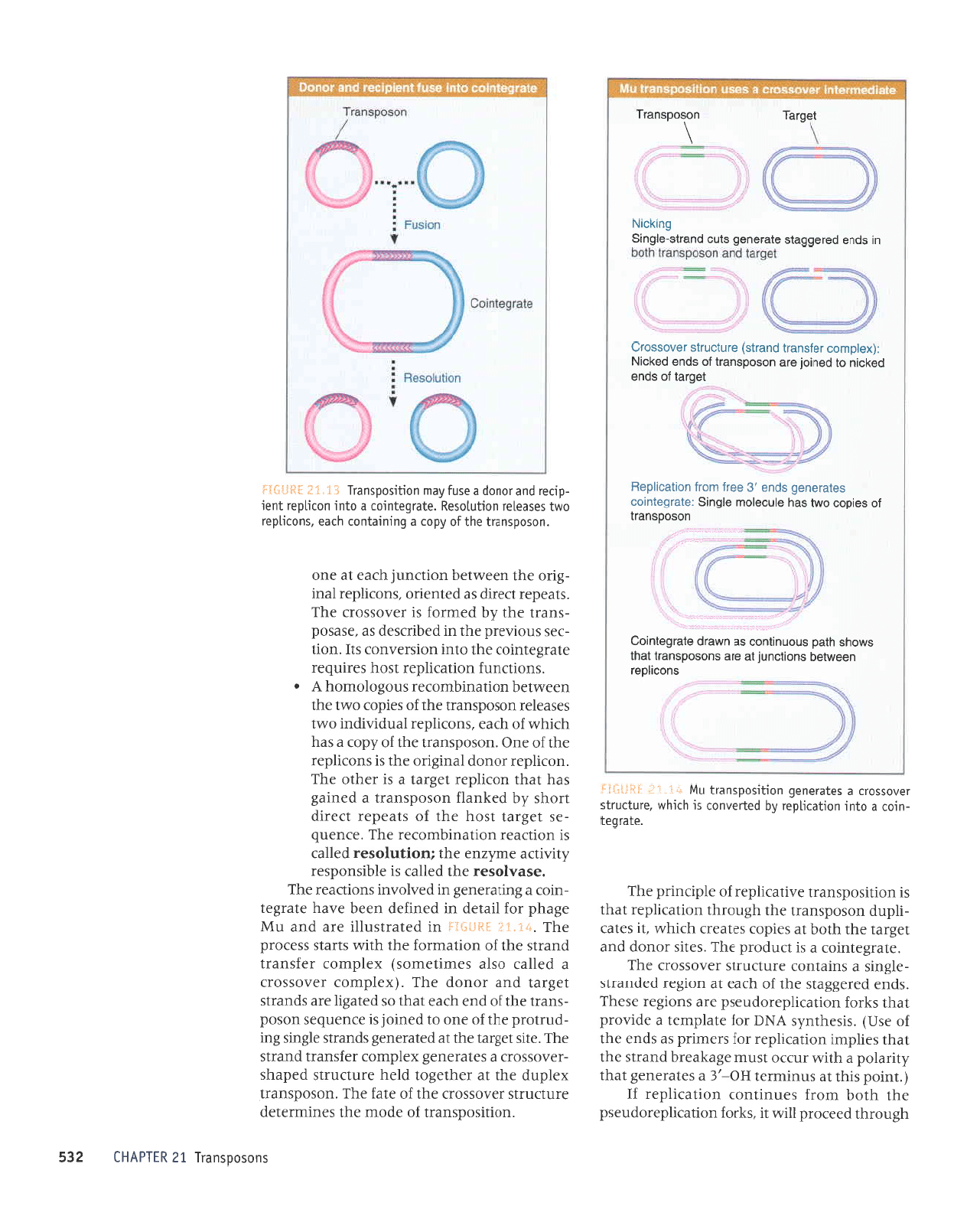
q8norqt peJJord
IIIM
tl
's>lroJ
uorleJrlderopnrsd
Jql
qloq
uroJJ sJnunuo)
uorlpJrldar
;1
('lu1od
srql
lp
snurrurJt
HO-,€
e
saleraua8
leql
.,(lrre1od
p
qlrM
JnJto
lsnru
aBelearq
pueJls
eql
leql
saqdrur
uorlel1dar
ro;
srarur,rd sp
spue aqt
yo
asn)
'srsaqtuLs
VNC
roJ
aleldutal
e apnord
leql
s>lJoJ uorlerrldaropnasd
are suor8ar
asaql
'spua
para88pls
Jql
Jo
qJpe
te
uor8ar
papuells
-a18uts
e suleluof,
Jrnlf,nrls
Ja^ossoJJ
JqJ
'elpJ8Jturo)
B sr
pnpord
JqI
'satrs
Jouop
pue
ta8rel
aqt
qloq
lp
sardor salpeJ) qJIqM
'tl
sete)
-Idnp
uosodsuprt
aqr
qBnorqt
uortBrrldar
teql
sr uorlrsodsuBtl
arrrlBrrldar yo
aldnurrd
aql
'a1erDa1
-uro)
p
olur uoLlerqdar
Aq
palanuor
sr
qlrqM
'olnllnlls
lenossolJ
e salerauab
uorlrsodsuetl
nW
i:-i'ii:
=H.i:*;d
suocrldat
ueemloq
suorlcunl
1e
ate suosodsuell
1eq1
s/v\oqs
tlled snonutluoc
sE
uA elp eler6elurog
,4,
.::l::;3].
uoso0sueJl
lo
serdoc oi
l
seLl alncoloul
e16urg :alet6aluroc
selereueO
spuo
,e
ooJ, rloll
uolleclldeg
1e6re1;o
spue
polcru
ol
peurol
e:e uosodsuell
]o
spua
po]ctN
:(xolduJoc
lolsuetl
puetls)
atnlcnrls re^ossoJC
ur spue
pere66els
eteteueb
slnc
puelgs-e16urg
DUTICTN
uosodsuBJl
1a6te1
suosoosuerl
Iz
ultdvHl z€g
'uortrsodsueJl
Jo
epou eql seuruJelJp
JIN]JNJIS
JEAOSSOJJ Aql
JO
J1PJ
JqJ
'UOSOdSUEJI
xaldnp
rql
te
raq1a3o1
plaq
arnlJnrls
padeqs
-JaAossoJJ
e saleJJueS xaldruor rJJSueJl
puEJls
JqJ'alls
1a8re1
aql
1e
paleraua8
spuerts alSurs 3ur
-pnrlord
Jqt
Jo
Juo ol
pJuroI
sr eJuenbes uosod
-suprl
aqt
Jo
pue
qJee
teqt
os
pale8q
JJp spupJls
tJBJpl
pup
Jouop
aq1
'(xaldruoJ
JeAossoJJ
e
pellpJ
osle sJrrrrleruos) xJldruoJ JJJsueJl
pueJls
Jql
Jo
uoBeruJoJ Jqt
qu,lr
suets
ssJJoJd
JqJ
'+r';J
:!lft$lJ
uI
pJleJlsnlll
aIP
puP
nW
a8eqd roJ
IrplJp
ur
pJurJJp
uaaq JAeq aler8al
-uro)
e Suueraua8 ur
pellolur
suop)eeJ eqJ
'asp^Iosa'I
eql
pJIIPJ
sr elqrsuodsar
,hr,l,rtre
au,{zua
Jqt luollnloseJ
pJIIeJ
sr uorl)eJJ
uorlPurqluoJJr JqJ'J)uJnb
-as
la8Jel lsoq
Jqt
yo
sleadar
lJaJrp
rroqs
,,(q
pJ>luelJ
uosodsueJl
p
peure8
spq
leqt
uorrldar
te8rcl
e sr Jeqto eqJ
'uorqdar
Jouop
leut8rro
aqt
sr suorrlda:
aqt
Jo
auo
'uosodsuerl
Jql
Io
^doJ e spq
q)rq,lr
Jo
qrea
'suorqdJJ
Ipnpr^rpur
o.trl
sJspJIaJ
uosodsueJl eql
Jo
seldoJ oM1 eql
ueJMlaq uorleurqruoJeJ
snoSoloruoe
V
.
'suorlJunJ
uorterrldat
lsoq
salrnbeJ
aleJSJlUrOJ
eql 01ur uorsJJ^uo)
sll
'uop
-ras
snor.Lard eql
ul
pJqrJ)sap
se
'asesod
-sueJt
aqt Lq
pJuJoJ
sr ranossorJ aqJ
'sleadar
tJJJIp
se
peluerJo
'suorqdar
pur
-3rro
aql uJJMleq
uorDunIqtee
le
Juo
'uosodsuell
eq11o
fidor
e 6urureluor
qrea'suorrtdet
oMl saseala.l
uoqnlosau
'a1e.rba1uror
e olur uorrldel
luer
-dtrer
pue.louop
p
asn; feu
uoqrsodsuetl
gf "IJ
*Sl]$il
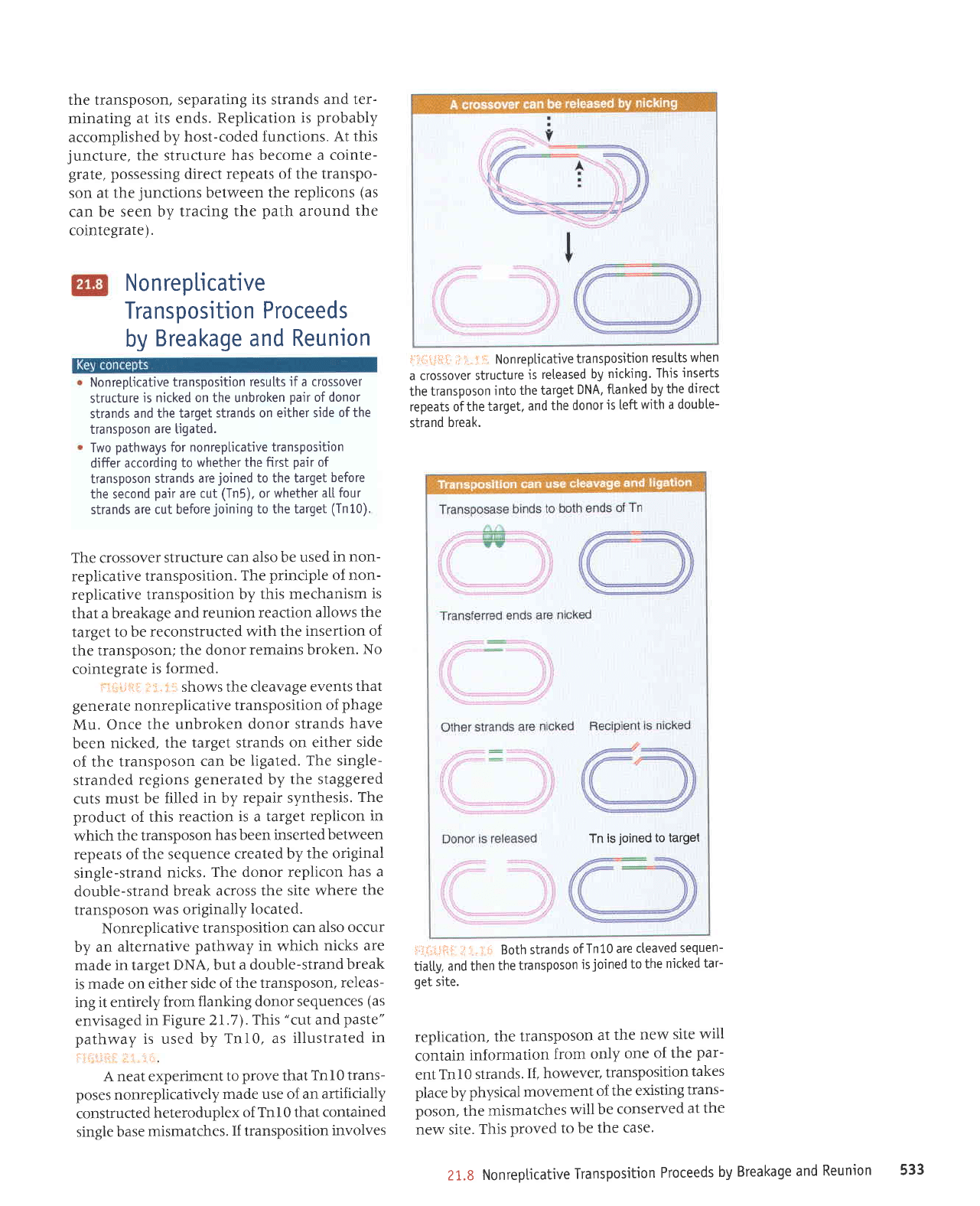
the transposon,
separating
its
strands
and ter-
minating
at
its
ends.
Replication is
probably
accomplished
by
host-coded functions.
At this
juncture,
the structure
has become a cointe-
grate, possessing
direct
repeats of the transpo-
son at the
junctions
between
the replicons
(as
can be seen
by tracing
the
path
around
the
cointegrate).
i:"ri.tiiil-
ii
!. l5 Nonrepticative
transposition
results
when
a crossover
structure
is
reteased
by
nicking.
This
inserts
the
transposon
into
the target
DNA,
ftanked by
the direct
repeats ofthe
target.
and
the donor
is teft
with a doubLe-
strand
break.
i:i-li-ilii
:.ii,ii: Both
strands
of
Tn10 are
cteaved
sequen-
tiaLty,
and then
the
transposon
isjoined
to the
njcked
tar-
get
site.
replication,
the transposon
at
the
new
site
will
contain
information
from
only
one
of the
par-
ent
Tnl0 strands.
If. however,
transposition
takes
place
by
physical movement
of the
existing
trans-
poson,
the
mismatches
will
be
conserved
at the
new site.
This
proved
to be
the
case.
21..8
Nonrepticative
Transposition
Proceeds
by
Breakage
and
Reunion
533
Nonrep[icative
Transposition
Proceeds
by
Breakage and Reunion
Nonrepticative
transposition
resutts
jf
a crossover
structure
is nicked on the unbroken
pair
of donor
strands
and the target
strands on either side
of the
transposon
are ligated.
Two
pathways
for nonreplicative
transposition
differ according
to whether
the first
pair
of
transposon
strands are
joined
to the target
before
the second
pair
are
cut
(Tn5).
or whether
a[[ four
strands are
cut before
joining
to the target
(Tn10).
The crossover
structure
can also be used
in
non-
replicative
transposition.
The
principle
of non-
replicative
transposition
by
this mechanism
is
that a breakage
and
reunion reaction
allows the
target to
be reconstructed
with the
insertion of
the
transposon;
the donor
remains broken.
No
cointegrate
is formed.
:-ir,.ii-:i: ,,
i-
:::
shows the cleavage
events
that
generate nonreplicative
transposition
of
phage
Mu. Once
the unbroken
donor strands
have
been
nicked,
the target strands
on either
side
of the
transposon
can be
ligated. The single-
stranded
regions
generated
by
the staggered
cuts
must be
filled
in
by
repair synthesis.
The
product
of this
reaction is a
target replicon
in
which
the transposon
has been inserted
between
repeats of
the sequence
created by
the original
single-strand
nicks.
The donor replicon
has a
double-strand
break across the
site where
the
transposon
was originally
located.
Nonreplicative
transposition
can
also occur
by an
alternative
pathway
in which
nicks are
made in target
DNA, but
a double-strand
break
is made
on either
side of
the transposon,
releas-
ing
it entirely
from
flanking donor sequences
(as
envisaged
in
Figure 21.7).
This
"cut
and
paste"
pathway is used by
Tnl0, as
illustrated
in
;;;l--;1'r::.iir.
A neat experiment
to
prove
that
Tnl0 trans-
poses
nonreplicatively
made use of an
artificially
constructed
heteroduplex
of Tnl0 that
contained
single base
mismatches.
If
transposition
involves
Tn
is
joined
to target
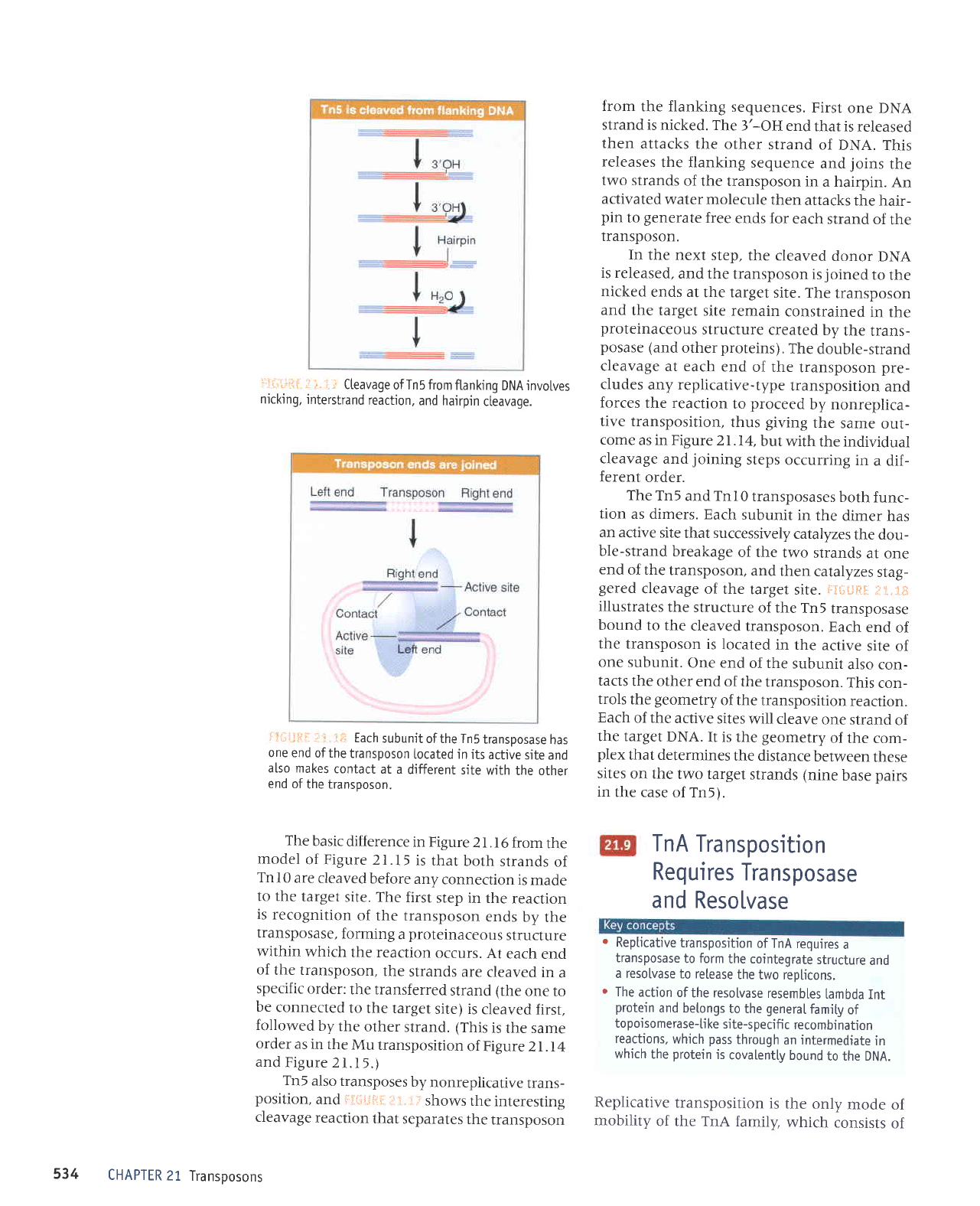
r
: i.ij
*i
.'l't..:
.:
Cteavage
of Tn 5 from
flanking
DNA involves
nicking,
interstrand
reaction,
and hairpjn
cleavaqe.
i:!r.:
:
;
+-:
::
Lr'i
. l: :r
Each
subunit
of the Tn
5
transDosase
nas
one end
of the
transposon
located in
its
active site
ano
also makes
contact
at a
different
site
with
the otner
end
of
the transposon.
The
basic
difference
in Figure
2l.l6
from
the
model
of Figure
21.15
is
that
both
strands
of
Tn10
are cleaved
before
any
connection
is
made
to the
target
site. The
first
step
in the
reaction
is
recognition
of the
transposon
ends
by
the
transposase,
forming
a
proteinaceous
structure
within
which
the reaction
occurs.
At
each
end
of
the transposon,
the
strands
are
cleaved
in
a
specific
order:
the transferred
strand
(the
one to
be
connected
to
the target
site) is
cleaved
first,
followed
by
the
other
strand.
(This
is
the same
order
as
in the
Mu
transposition
of Figure
2 I . l4
and
Figure
21.15.)
Tn5
also
transposes
by
nonreplicative
trans-
position,
and ;'i*l.it:tf ,l
i . ]. tr
shows
the
interesting
cleavage
reaction
that
separates
the
transposon
CHAPTER
21
Transposons
from
the flanking
sequences.
First
one DNA
strand is
nicked. The
3'-OH
end
that is
released
then
attacks
the other
strand
of
DNA.
This
releases
the flanking
sequence
and
joins
the
two strands
of
the transposon
in
a hairpin.
An
activated
water
molecule
then
attacks
the
hair-
pin
to
generate
free
ends for
each
strand
of
the
transposon.
In
the next
step,
the cleaved
donor
DNA
is released,
and the
transposon
is
joined
to
the
nicked
ends at
the target
site.
The
transposon
and
the target
site remain
constrained
in the
proteinaceous
structure
created
by
the
trans-
posase (and
other
proteins).
The
double-strand
cleavage
at each
end
of the
transposon pre-
cludes
any replicative-type
transposition
and
forces
the reaction
to
proceed
by nonreplica-
tive transposition,
thus
giving
the
same
out-
come
as in Figure
21.14,
but with
the individual
cleavage
and
joining
steps
occurring
in
a dif-
ferent
order.
The
Tn 5
and Tn I
0 transposases
both
func-
tion
as dimers.
Each
subunit
in
the
dimer
has
an active
site
that successively
catalyzes
the dou-
ble-strand
breakage
of the
two
strands
at one
end
of the
transposon,
and
then
catalyzes
stag-
gered
cleavage
of the
target
site.
{:i{llJfti
;ii.'lil
illustrates
the
structure
of the
Tn5
transposase
bound
to the
cleaved
transposon.
Each
end
of
the
transposon
is
located
in the
active
site of
one subunit.
One end
of the
subunit
also
con-
tacts
the other
end
of the
transposon.
This
con-
trols
the
geometry
of the
transposition
reaction.
Each
of the
active
sites
will cleave
one strand
of
the target
DNA.
It is the geometry
of
the com-
plex
that determines
the distance
between
these
sites
on the
two target
strands
(nine
base
pairs
in
the case
of Tn5).
TnA
Transposition
Requires
Transposase
and
Resolvase
.
Repticative
transposition
of TnA
requires
a
transposase
to form
the cointegrate
structure
and
a resotvase
to retease
the
two replicons.
r
The
action
of
the resolvase
resembtes
[ambda
Int
protein
and betongs
to the
general
famity
of
topoisomerase-tike
site-specifi
c recombination
reactions.
which
pass
through
an intermediate
in
which
the
protein
is
covalently
bound
to the DNA.
Replicative
transposition
is
the
only
mode
of
mobility
of the TnA
family,
which
consists
of
534
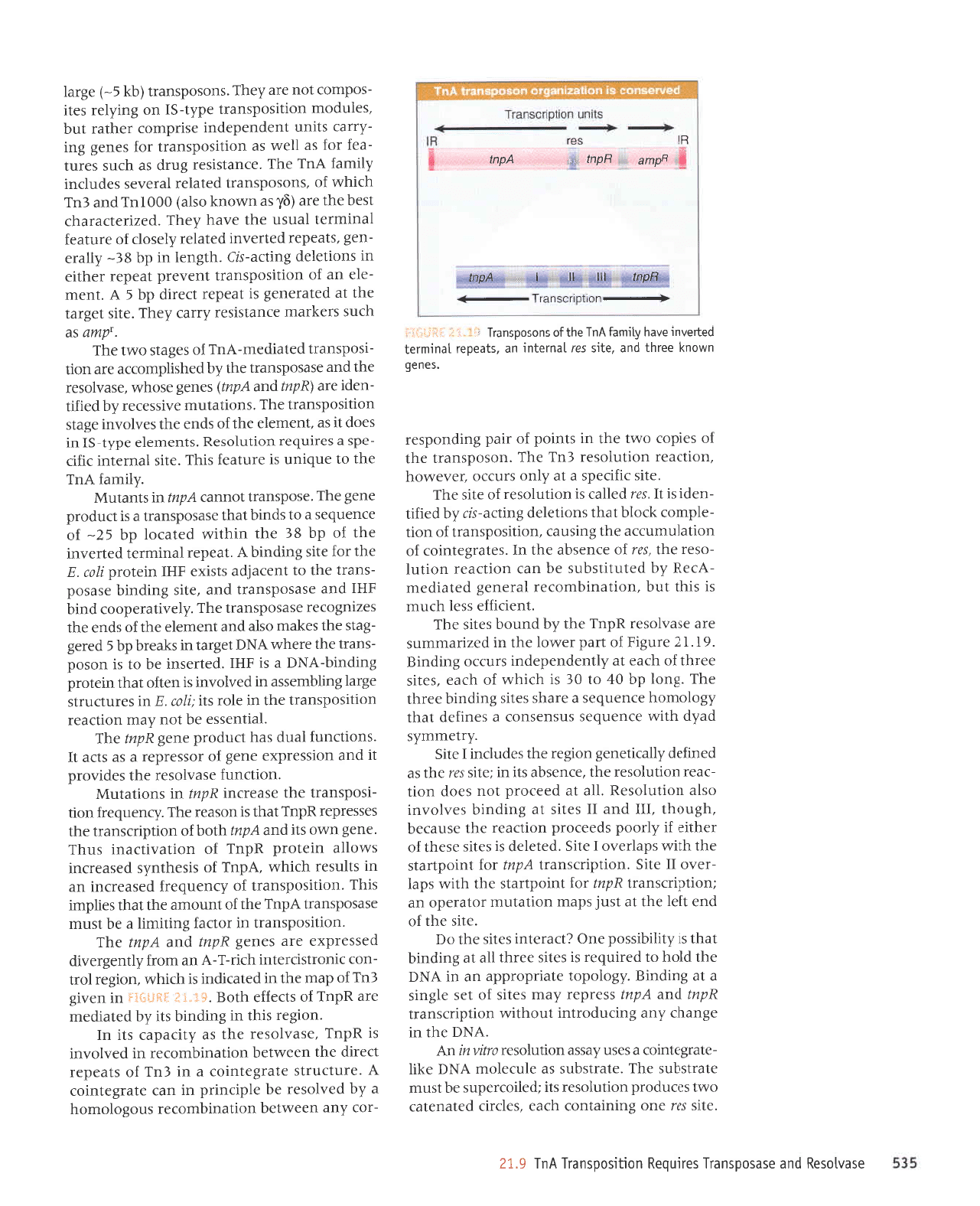
ase^losau
pue
aspsodsuelf salrnbau uor.]r.sodsuell
vul
6'IZ
'JllS
SrJ JUO
SurureluoJ
qJeJ
'SJIJJIJ
pJleueleJ
o,lrl saJnpord uorlnlosar
s1r
lpayorradns aq
lsnu
JleJlsqns
JqJ
'JleJlsqns
sP elnJJloru
vNo
a{ll
-aler8aluror
e sasn
Lesse uo:onIoseJulttutuV
'vNo
aql
uI
a8ueqr
.due
SuonpoJlur
lnoqlrm
uotldtrtsuerl
ydul
pue
ydul
ssatda,r
,(eur saus
Jo
las
a13urs
e
te
Surpurg
',{3o1odo1
aleudordde
ue uI
VNO
Jqt
ploq
o1
parrnbar
sr sells JJrqt
IIe
1e
Surputq
leql
sr,furlqrssod JUO
ZDerelur
sJtIS
Jql
oo
'JUs
eql
Io
puJ
lJel
aql
le tsnI
sderu uorte]nut
rolerado
ue
luorldrnsueilAdui roJ
lutoduels
aqt
qlr,r.r sdel
-JJAo
II
atrs
'uortdrrJsupJl
ydul
to1
lutoduets
Jqt
qtl,rl
sdepa,ro
l
etIS
'patJIJp
sI
sJtIS esJql
Jo
rJqlre
yr
Llrood spaarord
uoltJeeJ
Jqt asneJeq
'q8noqr 'I1I
puP
II
salls
le
Sutputq
saAIoAuI
oslp uorlnlosJU
'lle
1e
pa:rord
lou
sJop
uoll
-JeeJ
uorlnlosal
Jql
'eJuJsqe
su
uI
:elIS sal aql
se
pJurlrp.r{.1prr1aua3
uorSar
rql sepnlJul
I
ells
'.drtaruurz{.s
peLp qrrrr.l
aruanbas
snsuJsuoJ
e sauIJJp
leql
,{.3o1ouroq aruanbas e eJeqs
salts Sutputq
aarql
aq1
'3uo1
dq
97
ot
0€
sI
qrlqM
Jo
qrer
'srlls
Jarql
Jo
qJee
1e
r{ltuapuadapul
sJnJJo
Sutputg
'6I'IZ
arn8tg
;o
ued
rJMol Jqt
uI
pJzlleruurns
ere JSeAIoser
gdul
aqt
Lq
punoq sJtIS
eqJ
'tuJrJIJla
ssel
qJnu
sr srql
tnq
'uolteulqluoJJJ
lerauaB
palelpJlx
-VJJU
,{q
palnltlsqns
Jq
uel uoIlJPeJ
uollnl
-osal
Jql
'srl
Jo
JJuesqp Jql uI
'saler8alutor
;o
uorlelnrunJJe
aql Sursner
'uorlrsodsuPrl
Jo
uOIl
-aldruor
IJolq
leqt
suoltelep Suttre-str,lq
pagtr
-uJpr
sr
1I
ral
pslleJ
sr
uollnlosar
Jo
elIS
JqJ
'a1rs
rt;trads e
le
,{1uo sJnJto
tJAJMoq
'uorlJeJJ
uollnlosJr
€uJ
aql
'uosodsuerl
aql
;o
sardor
o,trt Jql ur slurod;o
rred
Surpuodsar
'sauab
uMou{ aorq}
pup
'alrs
sa./
lpuralut
ue
'sleadet
leutulal
peilenur
aneq r\1Lue1
yu1
aq1;o suosodsuell
,:
,
'i,,
,ii.:ii::!
j:l
-,ror
,{ue uaaMleq
uolleulqruorar
snoSoloruoq
e
dq
parrlosar aq
aldtrutrd
ut
uer aler8alutor
y
'eJnlJnJls
ale.rSaluroJ
p
uI
€uI
;o
sleadar
DJrrp
eql
uealltleq
uolleulqruoJeJ
uI
pJAIOAUI
sr
ydul
'JSeAIosaJ
Jql
se ,htreder
slt
uI
'uor8ar
slql
q
Surpurq
s1r
.dq
pateparu
are
5du1
Io
slrJIJe
qlog
'*tT"i;:'
.:lt{fi*i.*
ur ua,rt8
€uJ
Jo
deu aqt
u1
pete)Ipul sI
q)IqM
'uot3al
1or1
-uoJ
JruorlslJJelul
qJIr-I-y ue
uor;
dllua8rantp
passardxa are
saua8
ydul pue
Vdul
aqt
'uortrsodsuerl
uI
ropeJ 3ur1nu11
e eq
lsnu
asesodsuerl
Vdul
aqr;o
lunoue
Jql
leql
salldrut
srqJ
'uoltlsodsuett
;o
.{ruanbalJ
pJseerJul ue
ur sllnsJJ
rplqM
'VduI;o
stsaqlurls
paseeJJul
suolle
utalord
gdul
yo uoIlPAIlJeul
snql
'aua8
unro
s1I
pue
ydulqloqp
uorldrnsuerl
aq1
sassardar
gdul
teql
sI
uosear
aq1
'f,luanbaJJ
uoll
-rsodsue.rl
Jql
JSeJrlur
ydul
u\
suotlelnW
'uoll)unJ
JSe^loseJ
aql saPuord
lI
pue
uolssardxa
auaS;o
rossardar
€ se
slJe
1J
'suortJunl
Ienp
spq
pnpord
eua8
4du1
aq7
'lelluessJ
Jq
lou
,{eur uotllear
uortrsodsuerl
Jql ul
JIoJ sll
:!lu'E
uI sJrnlJnJls
a3,re1
Suqquessp
uI
peAIoAuI sI ueqo
]eql
utalold
Surpurq-y5111
p
sl
{HI
'pruJSuI
rq ol
sI uosod
-sue[
eqt
erequ
vN11
la8rel
uI slearq
dq
5
para8
-8ets
aql se>leru
os1e
pue
lueualJ
eql
Jo
spue eq]
sazruSorar
asesodsuerl
aql',{larrueradoor
putq
JHI
pue
asesodsuerl
pue
'JlIs
Surpurq
asesod
-sueJt
Jqt
ot
luarefpB
slslxe
dHI
utalotd
t1ot
'g
Jr{t
JoJ atls
Surpurq
y
'leadar
IeuIuJJl
pJueAuI
rql
Jo
dq
gt
eqr
ulqll,ln
prlProl dq
SZ-
Jo
aruanbas
e ol spulq
leq1
asesodsuerl
e
q
Dnpord
auaB
aq1'esodsue;l louuPJ
Vdut
ut
sluelnW
'AIIlueI
VUJ
aqt
ol anbtun
sI ernteeJ
sIqJ
'aqs
leulelul
JIJIf,
-ads
e salnbJJ
uoltnlosJg'sIuJIUJIJ
ad,{1-51
ut
sJop
ll
se
'luJlualJ
Jql
Jo
spuJ
aql
sallonut
a8els
uortrsodsuerl
eqJ
'suolPlnru
JAISsJ)Jr
,{q
pagq
-uJpr
aJp
(yduypueydryl saua?
esoqM
'asellosaJ
aql
pup
asesodsuen
aqt,{q
paqstdruorre
eJB uoll
-rsodsue:r
pJlplpJLu-Vu1
1o
sa8ets
oa,l) JrlJ
'fl1u0
se
qJns
sJe>lJpru
aJuPlsIsJJ
,{.rrer
daql
'atls
la8rel
Jql
te
pateJaua8 sr
leada:
narrp
dq
S
V
'lueu
-ela
up
;o
uorlrsodsuell
luarrard
lBadar
Jeqlle
ur suorlalep
Sutpe-su,
'r{13ua1
ut
dq
g5-.dgera
-ua8
'steadal
paua^ul
pJrPIJr z(1asop
Jo
JJnteJJ
IeurruJet
Iensn
eql azreq
Leql
'pJZIrJlJeJeq)
tsrq
eql
are
(gl"
se
uMou1
osle)
ggg
1u1pue
€uI
q)IqM
yo
'suosodsueJl
pelPIeJ
IeJeAes
sapnlJul
Lluey
VuJ
aqJ
'JJuelsISJJ
Snrp
se
q)ns
saJnl
-eeJ
JoJ sp
IIaM
se uotltsodsueJl
JoJ saua8
8ut
-.{rrer
slrun
luapuadaput
astrduror
JeqleJ
lnq
'selnpou
uolttsodsuerl
ad{t-SI
uo
3ut^d1ar
salt
-sodruor
lou
eJp.daql'suosodsuerl
(q1
5-)
a8rel
<
uotldtrcsuerl-
AdutiltlIVdut
adae
Hdut
.,.,
Vdul
gl
sor
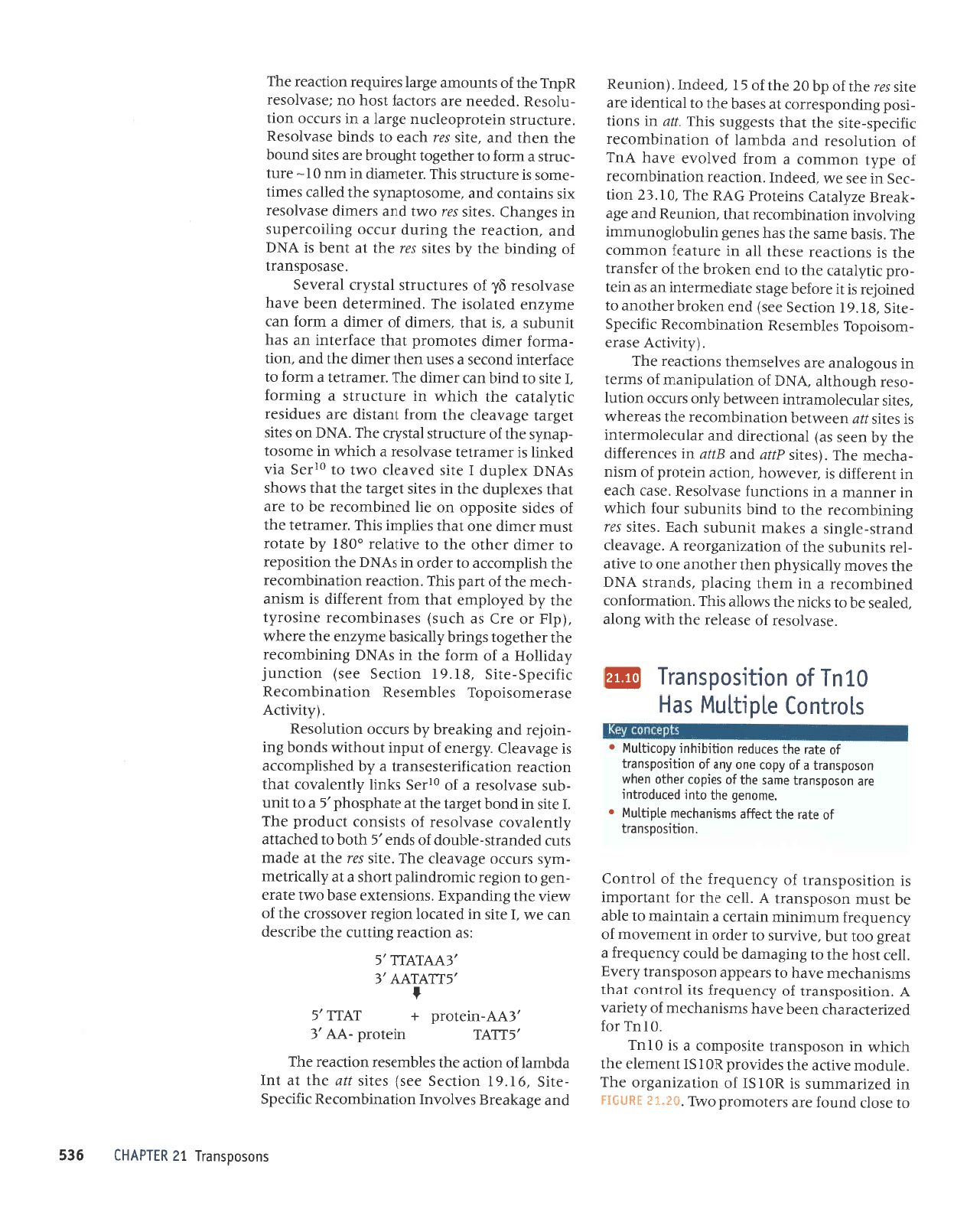
01 esolJ
punoJ
aJp
sJJloruoJd
o^41
.0e,IZ
lUn$IJ
ur
pJzrJpruruns
sr
U0ISI
Jo
uorlezrup8ro
aq1
'Jlnpou
JArlJp
Jqt sapnord
U0I
SI
tuaruJlJ
Jql
TIJIqM
ur uosodsuBJl
etlsodruoJ
e sr
0IuJ
'0IuJ
roJ
pazrJJppJeql
uJJq
JAeq
sursrueqJJru
Jo
Alauea
y
'uorlrsodsupJt
Jo
zbuanbar;
sl-r
IoJluoJ
teql
sursrueqJatu
elpq
ol
sreadde
uosodsuerl
^,{rang
'lleJ
rsoq
aqt
ol Sur8erupp
eq
plnoJ
zbuanbar;
e
lear8
ool
lnq
'aArAJns
01 JJpJo
ur
luJruJloru
Jo
druanbat;
urnurrurru
ureual
e urelureru
01 JIqe
aq
lsnru
uosodsuert
V
'lleJ
Jql
JoJ
tupuodrur
sr uorlrsodsupJt
Jo
z(ruanbar;
aqt
Jo loJtuo:)
'uorlLsodsuetl
J0
elpl
oql
lla#p
stustupqrau
a1dq1n61
r
'auouaE
aql
olul
palnpotlur
ete uosodsuetl
eues
aql
Jo
setdor
taqlo
uaqlr
uosodsuetl
e
1o
Ador
euo fue;o
uorltsodsuerl
J0
alei
aql salnpal
uoqrqrqur
{dorr11n11
o
slorluol
aldqlnw
sPH
0Iut
Jo
uorltsodsuerl
@
'JseAIosJJ
Jo
JSeJIaJ
aqt
qllm
Buolp
'pJIPes
eq ol
SIJIU
eql
s^\o[e
srr{J
'uorleu]oJuoJ
pJurqruoJal
e
ur rueql
8une1d
,spuells
vNC
Jql sJloru
z(1e;rs,{qd
uJqt
Jaqtoue
auo
01 elrle
-lal
slrunqns
Jql
Jo
uortezrue8roar y
.a8e,realr
puerts-alSurs
p
sJ>leu
lrunqns
qJell
'selrs
srl
Sururqruoral
aql
ot
purq
slunqns
JnoJ qJrqm
ur JJuupru
p
ur suorlJunJ
asp^losau
.eseJ
q)ea
ur
luJJaJJrp
sr
,renamoq
'uorlJp
uralord
Jo
rusru
-eqJeru
eql'(sa1rs
djto
pue
gjp
uI srruerJJJrp
aqt,{q
uaas
se)
IpuorDJJrp
pue
JplnJelotuJetur
sI sells
ll,
uJaMlJq
uorlpurquoJeJ
Jql seJJAqM
'sJlrs
JelnJJlorueJlur
uJJMlJq
z(po
srnrto
uonnl
-osar
q8noqlp
'vN(;o
uo4elndrupur
Jo
sruJel
ur
snoSoleup
aJe
senlesureql
suorlJeeJ
JqJ
'(A]r^rlJY
eSeJJ
-urosrodol
selquaseU
uortpurquorag
rr;oad5
-alls
'g
I'6I
uortJJS
aas)
pua
uJlorq
rJqloup
ol
paurolar
sl
ll
JJoJeq
a8els
aleparuJJtul
ue sp
ure]
-ord
rr/.1e1er
eqt
ol
pue
uJ>loJq
aql
Jo
rJJsupJl
Jql
sr suorlJeeJ
Jsaql
IIe
ur
eJnlpaJ
uourruoJ
JqJ
'srseq
Jrrrps
Jql
seq
saua8
uqnqol8oununur
3ur.t1ozlur
uorleurquof,JJ
leql
'uorunJu
pue
a8e
->lerrg
az[1u1e3
surelord
)VU
aqJ
,0I.€Z
uoll
-JAS
UI
JAS EAt
'PJJPUI'UOIIJEJI
UOIIEUIqIUOJEJ
yo
addl
uoruruof,
e
ruoJ;
peAIoAJ
aleq
VuI
Jo
uorlnlosar
pup
ppqruel
Jo
uorlpurquroJeJ
rr;rrads-a1rs
Jq1
teql
stsaSSns
s+II
.ila
ur
suorl
-rsod
Surpuodsarror
1p
seseq
aql ot
leJpuJpr
JJe
rlls
srr aqt
10
dq
0z
eql
Jo
s I
'peepul
'(uorunag
suosoosuPrl
tz
ulldvHl
g€g
pue
a8elearg
saAIoAuI uorlpurqruoJeg
rr;rtadg
-ells
'9
I'6I
uorpes
aas) salrs
ilo
elq7
le
tul
Epquel
Jo
uoulP
Jql salquresal
uorDeal
JqJ
,SIIVJ
uratoJd
-W
,t
,g11y-uralord
+
JyJJ,s
t
,SJJVJYV,€
,€YVJVJJ,S
:sp
uorDeJJ
Suptnr Jql
eqrJJsJp
uef,
a,lnr
'I
alrs
ur
paleJol
uor8ar rJnossorJ
Jql
Jo
zvrar^
eql Surpuedxg
'suorsualxa
aseq o,lr1 JlpJe
-ua8
o1 uor8ar
rnuorpuqed
uoqs
e
1e
z(1etrr1au
-ru.ds
srnrro
aSeneap
JqJ
'elrs
sal
Jtqt
lp
Jppru
slnJ
pJpupJls-Jlqnop
Jo
spua
/5
qloq
01
paqJellp
zlltualerror
JSpAIosJJ
Jo
slsrsuof,
pnpord
aql
'I
elrs ur
puoq
1a8re1
eq1
tp
Jlpqdsoqd,g
e 01
1r-un
-qns
aspAIosJJ
p
Jo
0rlJS
s>luq ,{1tua1elo;
reql
UOI]JEAJ
UOI1EJIJIJJISsSUEJ1
E dq
PAqSUdIIIOJJP
sr a8e,rea13
',{.Eraua;o
lndur
lnoqlri^
spuoq 8ur
-urolar
pue
3ur4earq,{q
s:nrro
uopnloseg
'(A1IAI1JV
JspJaruosrodol
salqruasaU
uorleurqruo)aU
rr;nad5-a1rS'gI'6I
uorlJJS
aas) uorDunI
,{epr11o11
p
Jo
ruroJ
aqt ur
sygq SururqrxoJeJ
aql raqlaSot
s3urrq dletrseq
aru,{zua
Jql
arJr{,lr
'(d1g
ro
Jr) sp
qtns)
saseurqruoJal
aursorll
eql ^q
pa,{o1dua
leqt
uorJ
tuaJaJJrp
sr
ursrup
-qJJIu
aqt
Jo
ued
srqJ
'uortf,pal
uorleurqruoJJr
aqt qslldruoJJe
ol JepJo
ul sVNq
Jqt uorlrsodeJ
ot Jerurp
Jaqlo
Jq1 01 JATIBIJJ
.09
I
^q
alploJ
lsnru
Jerurp
Juo
leqt
saudrur srql
'JarrertJl
aql
Jo
seprs
atrsoddo
uo JrT
pJurqruoJal
eQ 01
are
leql
saxaldnp
aql ur
salrs
la8rBt
arll
lpqt
s,lror{s
sYN(
xaldnp
I
Jtls
panpalf,
o1\^1 ot
orJeS
przt
pJ{ull
sr JJrrreJlJl
aseAIosJJ
p
qJrqM
Ur eurosol
-deu[s
aql
Jo
ernDnrls p1sfut
JqJ
'VN11
uo
sJtrs
te8Jpl
a8enealr
aql uoJJ
luetslp
JJe sanprsJJ
rr1I1e1er
aql
qJrqm
ur arnlJnJls
e Sunuro;
'I
elrs
ol
purq
ueJ Jarurp
aqJ'JJrrrprlJl
e
ruJoJ 01
eJeJJJtul
puoJes
e sJSn
ueql Jarup
eq1
pue
'uoB
-pruJoJ
rarurp
saloruord
leql
JJeJJalur
uE seq
llunqns
e
'sr
lpq]
'sJerurp
Jo
rsrurp
p
rxroJ ue)
arudzua palelosr
aqJ
'paururJtap
uaJq
a^Eq
espllosaJ
gl,
Jo
sJJntJnrls
1elsAr;
IeJaAeS
'JSeSOdSUPJI
;o
Surpurq
aqt Lq
selrs sal aql
te tuaq
sr
VNC
puP
'uollJeJJ
Jql
Surrnp
rn;ro
SurIorradns
ut
sa8ueq3
'salrs
srl
oml
pue
srarurp
aspllosaJ
xrs sureluo) pup
'aurosoldeuds
aq1
pallpJ
sarup
-JIITOS
Sr JJnlJnJlS
SrqJ'JJlaruprp
ur Iuu
0I-
arnl
-f,nJls
p
ruroJ
01 raqlaSor
tqSnorq
JJp
selrs
punoq
eql
uaql
pup
'elrs
sal
qJee
01 spurq
ese^losau
'JJnlf,nrls
ural0rdoapnu
a3re1 e ur
sJnJJo
uorl
-nlosJu
'pepJJu
aJe sJotf,pJ
lsoq
ou
jJseAIosJJ
gdul
aqr
yo
slunorue
a8rel
sarmbal
uorlJpJJ
aqJ
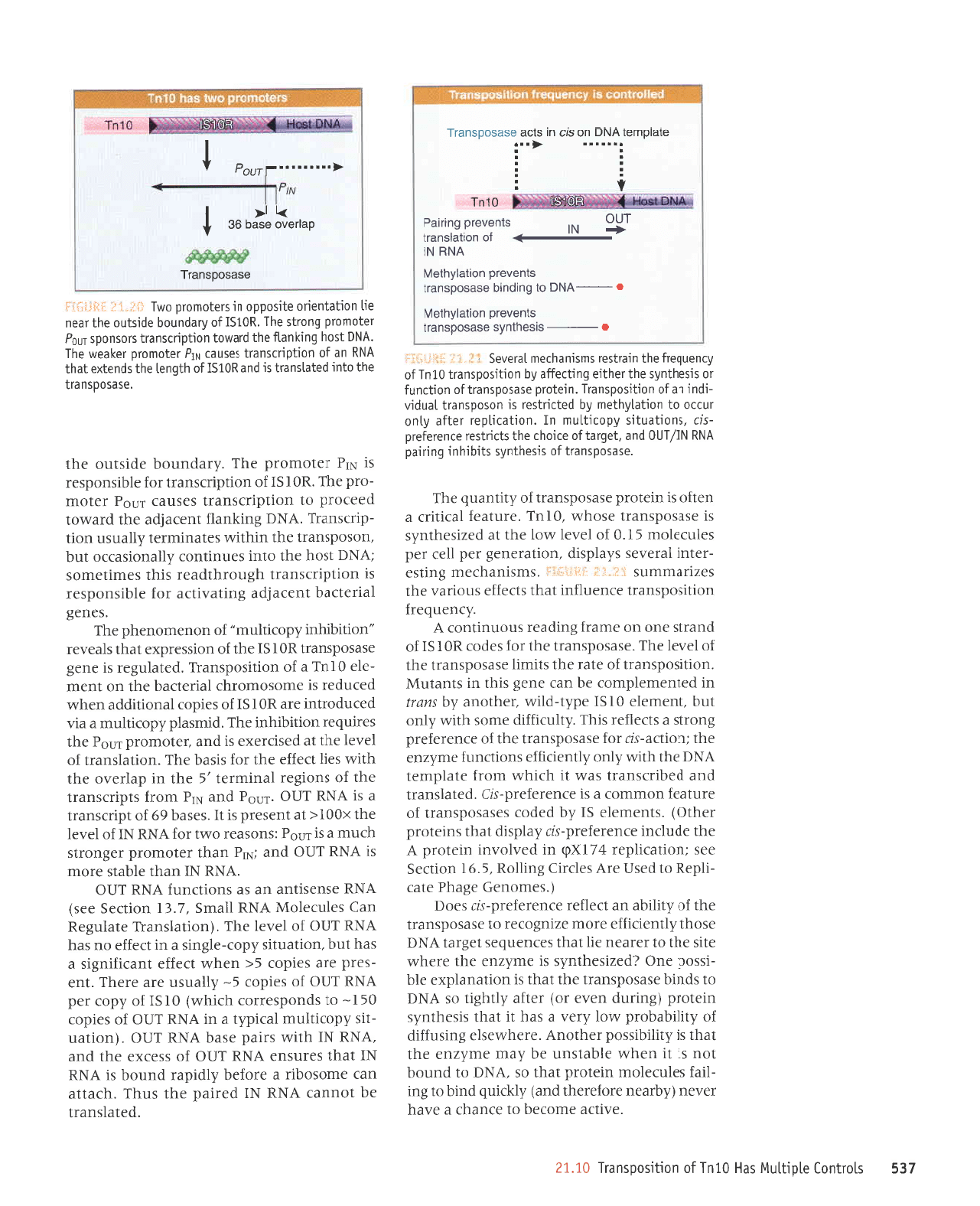
LE9
slorluol alorllnt^l
sPH
0Iul
Jo
uorlr.soosuP-JI
0t'lz
'JArlJe
auroJaq ol sJueqJ
e e^eq
re^Ju
(^qJeJu
JJoJJreql
pue)
^Hlrnb
purq
ot 3uI
-lreJ
sJInJJIoru uraloJd
teql
os
'vNC
()1
punoq
lou
Sr
1r
ueqM Jlqelsun Jq
,i.eu aru,{zua
aql
leqt
sI .dtrlqrssod Jeqtouv
'JJJqMJSIJ
Sutsn;1tp
;o
Ltrlqeqord .tro1 lran
e seq
]l teqt
srsaqlu,(s
uralo.rd
(Surrnp
uana ro) ralye
[1tq31r os
VN(
ot spurq asesodsuen Jqt
teqt
sr uoueueldxa
a1q
-rssod
aug
lpazrsaqlur{s
sr atuLzua
Jqt JJJqM
alrs eql ol
rJ.reJu JII
leql
saruanbas
ra8rel
ygq
asoql
.dpuanrJJa
erotu aztuSolar
ot asBsodsuetl
aqr
1o
Llqrqe ue
pJIJJT
aruaralard-sr
sJo(
('saruouag
a8eq4
ater
-lldJ6
rl1
pJsn
erv saprrJ 3ur11og
'E'9I
UoIDJS
JJs
luorlef,rldar
711ydl
ur
penlonur
utalord
v
aqt
JpnlJur
arua.ra;ard-sr Leldsrp
teqt
suratord
r3qlo)
'slueluelJ
51
.{q
papor
sasesodsuerl
;o
JrnleJJ uoruruoJ e sr aJuJrJlJrd-sl3'patelsuerl
pue pJqrJJSueJl
se.,ra.
rl
qJrqM
tuorl
ateldural
V.t{O
3q1
qlr.tr r(po [puaDr;;a
suollJunJ
au.dzua
aql
luorlJp-s7.r ro; asesodsueJl eql;o
aruaralard
Suorls e sDJIlar srql
'.{.t1nrr;;Ip
Jruos
qt1,lt
.{1uo
tnq'tuJuale
0ISI
ad,{t-p1t.tr'raqloue
Lq sua4
ur
pJluaualdruor
aq uer aue8 srql
ur sluelnw
'uorlrsodsuert
Jo
Jtpr Jqt
stlurrl aspsodsuprt
aql
Jo Ia^JI
aq1
'asesodsuerl
aqt ro; sJpor
U0 I SI
Jo
pueJls
Juo uo auer; SurpeJr
snonurluoJ
V_
'AJUJnDeTJ
uorlrsodsuerl JJuenlJur
leql
speJJJ
snoIJeA
eql
sJZIJeLULUnS
i
,t
;.;
:i::li'-.--
'
'SUISIUPqJJUT
SUrlSa
-JJlur
IeJJAes
sri.eldsrp
'uorlerauaS
rad
11ar
rad
sJlnJelou
E
I'0
Jo Ia^JI
^1.ol aql
le
paztsaqlu,(s
sr asBsodsueJl JSoqM
'0IuI 'Jrnleel
Ip)IurJ
e
uJUo sr
uratord asesodsuel;o
^tllupnb aqJ
'asesodsuetl
1o
sLsaqluAs
sltqLqur
6uured
VNU NI/ln0
pue
'1abre1;o
altoqr oq]
sllulsal atualaJeld
-sr,
'suorlenlLs
AdorLllnLu u1
'uoLlerqdar
ra1;e
[1uo
lnlo ol
uoLlelAqlau Aq
palrulsar
sL uosodsuetl
lenpLn
-rpur.
up
1o
uoLlrsodsuerl
'uLalord
asesodsuerl
1o
uotllunJ
ro sLsaqlufs eql reqlre 6ur1ra11e
fq
uoLlLsodsuerl
0tu1
Jo
Aruanbe4eql urelJsol sutsrupqlaur
lpra^es
,
r',
r :i;;iirii:i
o
-
stserJluls
asesodsuB1l
slueneld
uorlelr{q1eY1
o
-VNCI
o1 Ourpurq
esesodsue:l
sluenetd uoue1,{q1eY1
VNU NI
-- tvsv!+elvve'+
+
Nt ^.,,:^
fnO
sluanetd
6uute6
OLUI
A:
:......
1..i
elelduo]
VNO
uo src ur slce
osesodsuell
'pJlPISueJl
Jq
louuel
vNu
NI
parred eq1 snqJ
'rlJ€lle
uPJ aruosoqlJ
E eJoJJq
z{lptder
punoq
sl
vNu
NI
]pql
sJrnsue
vNu
Ino
Jo
ssaJxe eql
pue
'vNu
NI
qlp,r srred aseq
vNu
1ng
'(uotlen
-trs
.ddorrtlnu
1errd,{.1
e ul
yNU
JnO
Jo
sJldol
0EI-
ol spuodseJro)
qtlqm)
0ISI
Jo,{.dor
rad
vNU
IOO
;o
satdol
E-
Lllensn ere
rrrqJ
'luJ
-sard
are sJIdoJ
E<
uJqM
pJJJJ
luelIJIuBIS
e
seq
lnq
'uorlenlls
u(dor-a18urs
e uI
DJJJJ
ou seq
yNU
JOO
Jo le^rl
aq1'(uoqelsuer,l
ateln8ag
up) selnlalow
vNu
IIPlus
'1,'€I
uolDas ers)
\/Nu
JSuJSIlue
ue
se suoll)unJ
YNU
Jno
'vNu
NI
ueql Jlqels
erou
sl
vNU
JnO
pue
'uI4
ueel JJtoruoJd:a8uorts
q)nru
e 51
rno4
:suospal omt
JoJ
VNU NI
Jo IJAJI
rql
x00I<
le
luasard
sl
1I
'saseq
69
1o
ldursuerl
e sl
VNU
1ng
'rno4
pue
Nld
ruor; sldtrrsuerl
aqt
Jo
suoISJJ
IeulurJl ,S
eql ur delra,Lo
aql
qlrM sarT
1)aJIJ
eql
JoJ sISPq aqJ,
'uouelsuPJl
Jo
IJ^31
Jql
tP
pesrJJJXe sI
pue
lelouoJd
rnod
Jql
sarrnbar
uoplqlqul
aq1
'pturseld
z{dolulnru e
en
paJnporlul rre
U0I SI
Jo
sardor
lPuolllppe
uaqM
paJnpaJ sr eurosourorqJ
IeIJeDeq
Jq1 uo
lueu
-alJ
0IuI
e;o uotltsodsue4l'paleln8ar
sr aua8
esesodsueJl
U0
I SI
eqt
Jo
uolsserdxa
leqt
sleeler
,,uortrqrqul
Ldotr11nur,,
Jo
uouaurouaqd
aql
'sauaB
IerJal)eq
tuarelpe
3u1terr1lre
ro; alqtsuodsar
sr
uorldrJJSueJl
qSnoJqlpPar slql
sJrullaruos
lvN(
tsoq
Jq1 olq
senulluoJ
,(lleuotseDo
lnq
'uosodsueJl
aql
ulquM
sJlPuIUrrJl
[lenSn UOtl
-drnsuerl
'y1qq
Suqueg
luarelpe
eql
premol
paarord ol uotldlrlsuerl
sJsnef,
rnod
JJloru
-ord
aq1
'U0I
SI
Jo
uoltdlrJsueJl
ro; alqtsuodsar
sr
NId
retoruord
aq1
'Lrepunoq
JpIStno
eql
'asPs00
su ell
aql
olur
palelsupjl
sr.
pup
UOISI
Jo
qfuel eq1 spualxa
lPql
VNU
up
1o
uotldursuerl
sesnel
NId
lalouold laleaM
eql
'VN0
lsoq
6u11ue11
oql
preMol
uoqdursuell
51e5Llqd5
rn04
ralouord
6uor1s aq1
'UgISI
Jo
&epunoq
aptslno aql leau
arl
uoqeluauo
altsoddo
ut slelouold
oMl
*;:'
{,l
:iiit'.}i.l
asesoqsuejl
de;reno
eseq
ge
t
>r
r<
I
<.........)nod
t
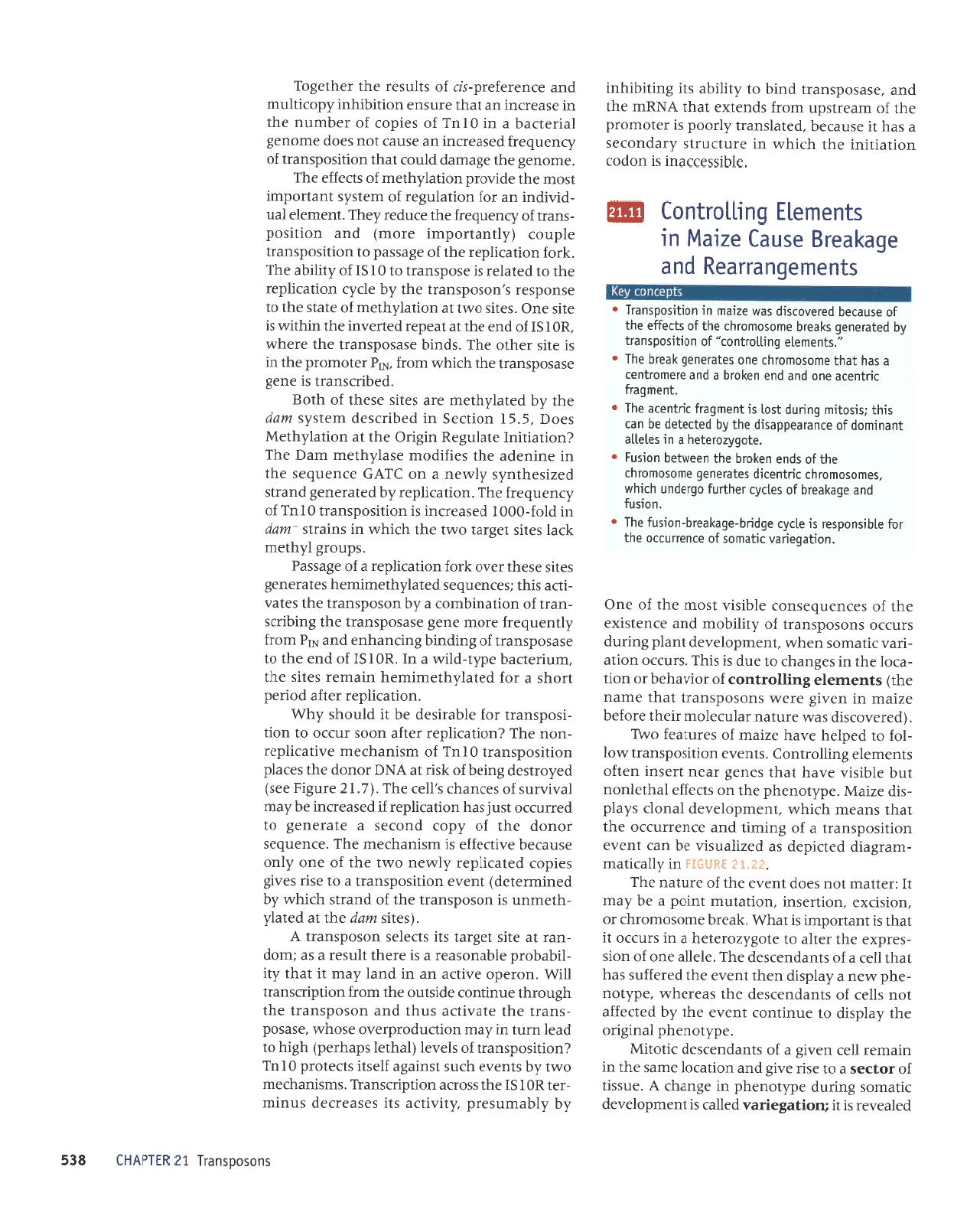
suosoosuPll
Iz
,(q
,{lqerunsard
',hr,r.rtre
slr seseeJJJp
snurru
-JJ]
U0I SI
eq1 ssorJe
uopdlJ)suP{l
'sursrueqJeu
o,u1 Lq
sluelJ
qrns
lsure8e
JIJsll
sDaloJd
0tut
Zuorlrsodsuerl
Jo
slrlrl
(pqra1sdeqrad)
q8rq
or
peal
uJnl
ur z{.Bru uorDnpordrano
esoqM
'asesod
-sueJl
eql alp^rlJp
snrll
pup
uosodsuerl aql
qSnorqt
JnurluoJ
eprslno Jql
ruoJJ uorldlnsuerl
11t1,1
'uorado
alrlJe
up ur
puel
,{eru
tr reqr
z(f1
-lqeqord
alqeuoseal
p
sr eJeql
tFSaJ
e sp
lruop
-upJ
le
alls
la3rel
sll
sDalas uosodsuerl
y
'(says
wap
aqt
te
pa1e1L
-qleuun
sr uosodsuerr
Jql
Jo
pupJls
qrrq,u
z(q
paururatap)
luJ^J
uorUsodsuerl e
ol asrr sa.a,r8
sardor
palerrldar
z(1.tzrau
olrt
eql
;o
auo .d1uo
esneJeq J TDJJJe
sr usrupqJatu
aq1
'a:uanbas
Jouop
eql
Jo
,{dol
puoras
e aleraua8
ol
pJJJnJJo
tsnI
seq uorlBt{dar
F
peseJJJur
aq deur
Iplrnrns
Jo
sJJueqr
s,llal aqJ
'(4'17
arn8r4 aas)
pal.onsap
Suraq;o >lsrr
te
yNO
Jouop aqt sareld
uorlrsodsueJl
0IuJ
Jo
rusrupqJJru a,rrterrldar
-uou
JqJ
;uogerqdar
JaUe uoos Jn))o
01 uorl
-rsodsuerl
JoJ elqerrsep
Jq
tl
plnoqs
IqM
'uorlerqdar
ra4e
porrad
iloqs
e roy
pate1,{qtJrurruJq
urprueJ sJtrs
aql
'runrrJtreq
adz(t-ppzr
e uI
'U0I
SI
Jo
pue
eq1 01
asesodsue.rl
1o
Surpurq
SurJuequJ
pue
NI4
ruor;
,{1luanbar;
aroru
aua8 asesodsuerl
aql Surquts
-upJl
Jo
uorleurquo)
e
dq
uosodsueJl
ar{l selpl
-u)e
srql
lsaruanbas
paleldqrarururaq
saleraua8
satls esaqt
Ja^o >lroJ
uope;qdar e;o
a8esse4
'sdnor8
ldqraru
>lJpl
setrs
le8ret
oaat eql
qJrqm
ur su\eJls
_utop
ul
ploJ-000I
pJSpeJJur
sr uorlrsodsuerl
0IuJ
Jo
,{ruanbar;
JqJ'uorteJllda:,{.q pateraua8 puerls
pazrsaqluz(s
,{1aaau
p
uo
)JVt
atuanbas
aql
ur Juruape
Jql serJrpotu
aselz(qtaru tup(
JqJ
Zuortenrul
ateln8ag
ur3rrg aql
le
uortpl^qlJw
seo0
'S'sI
uorlJes ur
paqrJJsep
utatstrs
wap
aqt ,{q
palellqlaru
ere satrs
asaql
Jo
qlog
'pJqrJlsueJt
sr
aua8
asesodsuerl
Jqt
qJrqM
rrroJJ
'lrtd
raloruord
aq1 ur
sr etrs raqlo
JqJ
'spurq
asesodsuerl
Jqt alaqM
'U0I
SI
Io
pua
aql
1e
leadar
palJenur
Jr{l urqtrM
sr
JlIs
auo
'sJlls
o^{l
le
uortelr{qlarrr
Jo
Jlpls
Jql 01
asuodsar
s,uosodsuerl
aqt dq
ap[l uorlerqdar
Jql
ot
patelar
sr asodsuert
01
0I
SI
yo
zlqrqe
aq1
'>lJoJ
uollPJlldar
aqr;o a8essed
o1 uorlrsodsuB:l
aldno;
(,{liuerrodrur
aroru)
pue
uorlrsod
-sueJt
Jo
zbuanbarl
Jr{l
a)npaJ,{aq1
'ruaruala
pn
-pl^Ipul
ue
JoJ uorleln8ar
Jo
ruatsr{s
luBuodrur
tsoru
eq1
aprnord uor1e1,{qtaru;o
sDeJJJ JqJ
'aruoua8
aqt
a8eruep
plno)
lpq1
uoltlsodsuerl;o
,{:uanbar; peseJJJur
ue esneJ
lou
saop auroua8
IeIJJt)eq
e uI
0IuI
;o
sardo;
Jo
JJqunu
aql
uI eseJJlur
up
leql
eJnsuJ uortrqrqur
Ldorrllnru
pue
aJuaJJJard-sr
Jo
stlnsal aql raqla3o1
U]IdVH] 8€9
pJIpaAJJ
sr
1r
iuolle8alJea
pJIIpJ
sr
luarudolanap
Jrleruos
Surrnp adzhouaqd
ur a8ueqt
V
'Jnssll
Jo
JolJas e 01 esrJ
aar8
pue
uorleJol
erups
Jql ul
urpurJJ
lar
uazrrS
p
Jo
sluepua)sJp
Jrlollw
'addlouaqd
leurSrro
aqr .deldstp
01 Jnulluor
tuenJ
Jql ,(q
papaJJe
tou
sllal
Jo
sluepueJsJp
Jql spJrJqM
,adr{tou
-aqd
'r-au
e z(eldsrp
urql
1uJ^e
Jql
prrJlJns
seq
lPq1
IIJJ
P
Jo
sluepuJ)sap
JqJ'alafle
auo
Jo
uors
-sardxa
aql JJlle
o1 alo8,{zorataq
e ur
sJnf,)o
lr
lpql
sI
lupuodun
sr
leqM
'>leJJq
Jrxosoruorq)
Jo
'uorsr)xa 'uoruesur
'uorlelnru
tulod
e
aq,{eru
1r
:Ianp."
10u
srop
*:1-"
-ryi_1"-:]"1:i_r!.
ef iJ
lHft3IJ
ur ^llprrtpur
-ruer8erp
paurdap
se
pJzrlpnsrl
aq ueJ
tuJ^e
uolllsodsuert e
Jo
3unu11 pup
e)uJrln)Jo
Jql
leql
sueJlu
qJIqM
'tuarudola,rap
leuop
sz(e1d
-slp
JZIeW
'ed,(rouaqd
Jqt uo sttJJJJ
IpqteFou
tnq
alqrsrl J^eq
leqt
saua8 reau
lJJSur
uetJo
slueuelJ
8urt1or1uo3'sluale
uorlrsodsuerl,laol
-loJ
or
padlaq
aAPq
ezreru
Jo
sarnleeJ
o^41
'(paranorsry
se,la. Jrnteu
JelnJJloru
JrJql
aJoJJq
ezreur
ur ua,lr8
aJJM suosodsuerl
lpql
arupu
aql) sluaruala
8u1lorluoJ
Jo
Jorleqaq
ro
uorl
-pJol
eql
ur sa8ueqr
01 Jnp
sl slqJ
'sJnJJo
uorle
-rJeA
lrleuros
ueqM
'luarudola,rap
lupld
Surrnp
sJnJ)o
suosodsuerl
Jo
z(lllqour pue
aJuelsrxJ
eql
Jo
saluanbasuoJ
JIqrsrA
lsou
eqt
Jo
euo
'uorlebapen
tgpulos
Jo
atuollnllo
aql
ro1 elqrsuodsat
sr
alrr\r abpuq-a6e4earQ-uorsnj
oll
o
'uorsnJ
pue
a6e4earq;o
se1rfir taqln;
obrapun qltqm
'sauosouol
qt
luluallp
salelauab
euosoutolt.ll
aql
J0
spue
ualotq
aql uaeMlaq
uorsnl
o
'a1o6r\zorelaq
p
ur selallp
+ueururop
4o
arueteaddeslp
oql
fq pallalap
aq
uel
su.ll
jsrsoltul
6uunp
1so1
sr
lueu6et;
luJuotp_a!l
o
'luaube4
lulualp
ouo
pup
pua
uololq
e
pue
olaulotlual
p
spq
leql
ouosoruolLll
euo
salerauab >lperQ
a{f
o
,,'sluauale
6urt1ot1uor,,
;o
uoqrsodsuetl
fq
paletauaE
slpalq
auosoruolqr
aql
Jo
slto#e
eql
Jo
asnplaq
pala^olsrp
spM
azrpur
ur uorlrsodsuell
.
sluauabuPJrPau
puP
a6elealg
esnel
azrp6
ut
quauell
6urtlor1uo3
@
'elqrssaJ)eur
sr
uopoJ
uollelllul
aql
qrlq.&t
ur eJnlf,nJls
[repuoras
e seq
1l
asneraq
'pelplsuerl
Alrood
sr raloruord
aq1
Jo
rupJJlsdn
ruor;
spuetxe
leql
VNUru
aql
pue
'asesodsuert
purq
ol ^l{Iqe
s1r Surlrqrqur
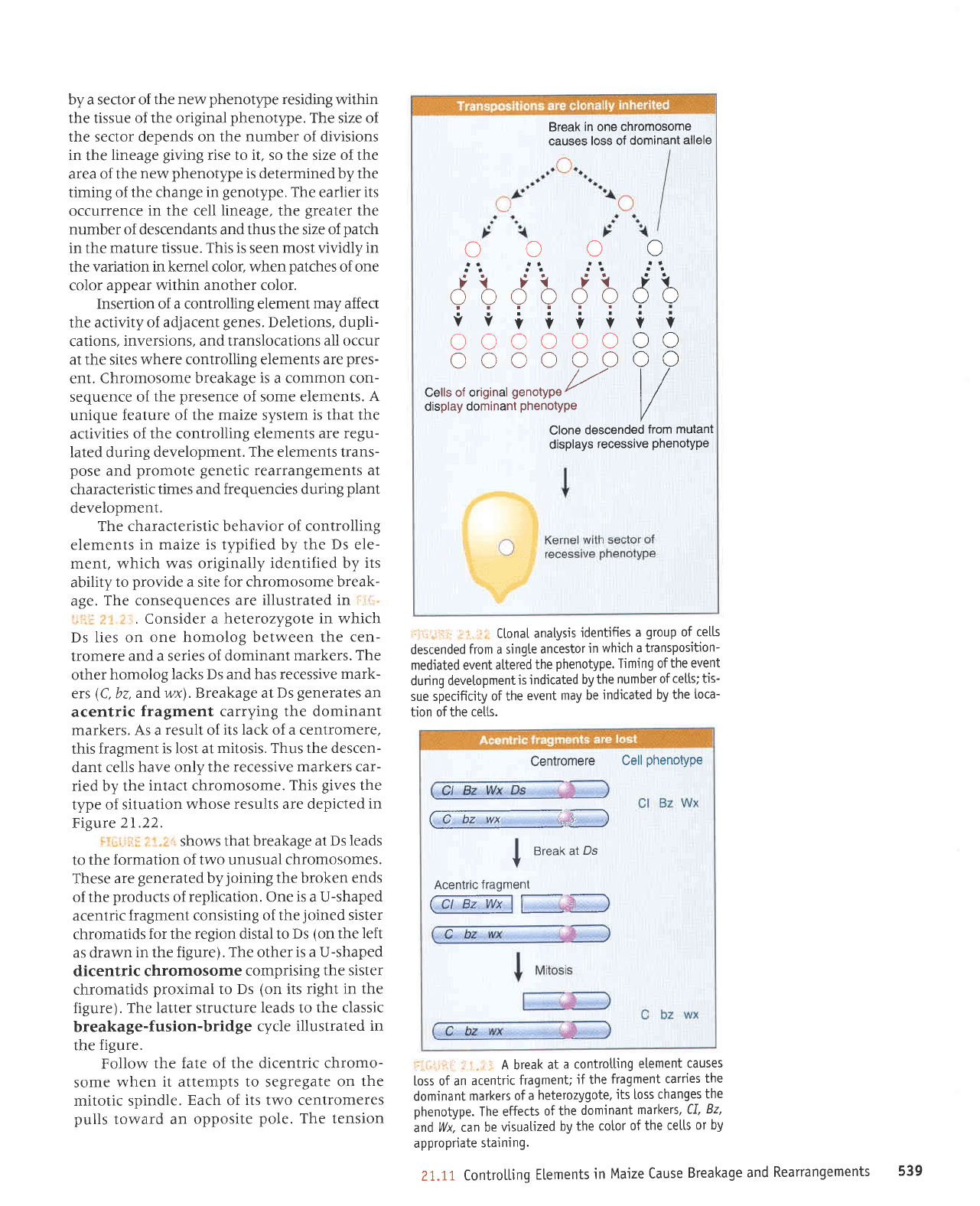
by a sector of
the new
phenotlpe
residing
within
the tissue
of the original
phenotype.
The size of
the sector depends on the
number
of divisions
in the
lineage
giving
rise to it, so the size of the
area of the
new
phenotype
is determined by the
timing of the change
in
genotype.
The earlier
its
occurrence
in the cell lineage, the
greater
the
number of descendants and thus the size of
patch
in the mature tissue.
This is
seen
most vividly in
the
variation in kemel color, when
patches
of one
color appear
within another color.
Insertion of a controlling element
may affect
the activity
of adjacent
genes.
Deletions, dupli-
cations,
inversions, and translocations
all occur
at the sites where controlling elements
are
pres-
ent. Chromosome
breakage is a common con-
sequence of
the
presence
of some elements.
A
unique
feature of
the maize
system
is that the
activities
of the controlling elements
are regu-
lated during
development. The elements trans-
pose
and
promote genetic
rearrangements at
characteristic
times and frequencies during
plant
development.
The characteristic behavior of controlling
elements
in maize is typified by the Ds ele-
ment, which
was originally identified by
its
ability
to
provide
a site
for chromosome break-
age.
The consequences are
illustrated in
r:i,-
.::.:i
.
. :.
Consider a heterozygote
in which
Ds lies on
one homolog between the
cen-
tromere
and a series of dominant
markers. The
other
homolog
lacks Ds and has recessive
mark-
ers
(C
bz,
andwx). Breakage at
Ds
generates
an
acentric
fragment carrying the dominant
markers. As a
result
of
its lack of a centromere,
this fragment
is lost at
mitosis. Thus the descen-
dant
cells
have only the recessive
markers car-
ried by the
intact chromosome.
This
gives
the
type
of situation
whose results are depicted
in
Figure
2I.22.
:'
:.!.:.i'ri
,
,.,
shows that breakage
at Ds leads
to the formation
of two unusual chromosomes.
These are
generated
byjoining
the broken ends
of the
products
of
replication. One is a U-shaped
acentric
fragment consisting of
the
joined
sister
chromatids
for the region distal to
Ds
(on
the
left
as drawn
in the figure). The other
is a U-shaped
dicentric
chromosome
comprising
the sister
chromatids
proximal
to Ds
(on
its right
in the
figure). The
latter structure leads to
the classic
breakage-fusion-bridge
cycle illustrated
in
the
figure.
Follow
the fate of the dicentric
chromo-
some
when
it attempts to segregate
on the
mitotic spindle.
Each
of
its two centromeres
pulls
toward an
opposite
pole.
The tension
: li-,iriiit.
l.
.,i
:
Clonal
anatysis
identifies
a
group
of cetls
descended
from a singte
ancestor
in
which a transposition-
mediated event
altered
the
phenotype. Timing ofthe
event
during devetopment
is indicated
by
the
number of
ceLts; tis-
sue specificity
of the
event
may be
indicated
by the
[oca-
tion ofthe cetts.
ii'i,i.iiii:
..:
ii I
A break
at
a controtling
element
causes
loss of an
acentric
fragmenU
if the
fragment
carries
the
dominant
markers
of a
heterozygote,
jts
loss
changes
the
phenotype.
The effects
of
the
dominant
markers,
CI,
Bz,
and
Wx, can be
vjsuatized
by the
cotor
of the
celts
or by
appropriate
staining.
21.11
Controttinq
Elements
in
Maize Cause
Breakage
and
Rearrangements
539
Break
in one chromosome
causes
loss of
dominant
allele
oooc
ta
It
't't
tl
tl
tl
ti
oooooooo
iiiiiiii
oooooooo
oooooooo
t/
Cells of original
genotype
r
| /
display
dominant
phenotype
V
Clone
descended
from mutant
disPlaYs
recessive
Phenotype
Centromere
Cell
PhenotYPe
@
I
ereak at
Ds
Y
Acentric
f ragment
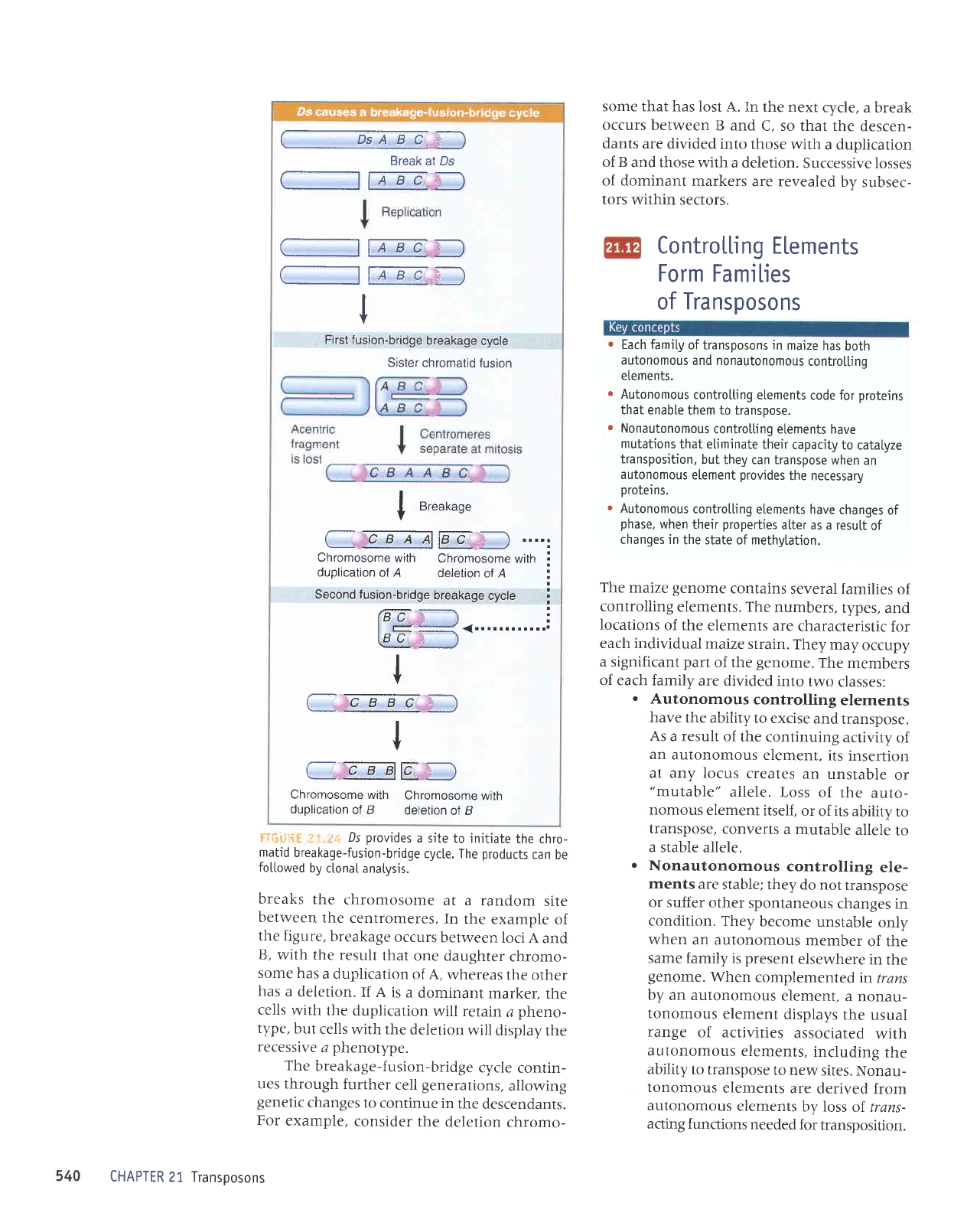
C-------gr--4-E-c.,,
:]
Break at Ds
c-----_l
t-I-E-el
CfA
B-dI)
I
Y
First fusion-bridge
breakage
cycle
Sister
chromatid f
usion
I
I
Breaka9e
C-
-c-B-A-AIIB
c.,-
....:
Chromosome
with
Chromosome
with
!
duplication
of A
deletion
of A
:
Second fusion-bridge
breakage
cycle
:
trc
-----\
:
r-=
€c''
'
I
I
/---;---;--;---=--\
\-utrtrv__)
I
I
r-.-:---=:--AG_.------\
L_
r, r, rrl
v._ __)
Chromosome
with
Chromosome
with
duplication
of B
deletion
of B
some that has lost
A. In the next
cycle,
a break
occurs between
B and
C, so that
the descen-
dants are
divided into
those with
a duplication
of B
and those
with a deletion.
Successive
losses
of dominant
markers
are revealed
by
subsec-
tors
within sectors.
-,
'r'
.
'
Ds
provides
a site
to initiate
the chro-
matid
breakage-fusion-bridge
cycle. The
products
can
be
fotlowed
by
clonaI anatysis.
breaks
the
chromosome
at a random
site
between
the
centromeres.
In
the example
of
the
figure,
breakage
occurs
between
loci A
and
B, with
the
result
that
one daughter
chromo-
some
has
a duplication
of A, whereas
the other
has a
deietion.
If
A is a
dominant
marker,
the
cells
with
the duplication
will retain
a
pheno-
type,
but
cells
with the
deletion will
display
the
recessive
a
phenotype.
The
breakage-fusion-bridge
cycle
contin-
ues through
further
cell
generations,
allowing
genetic
changes
to continue
in
the
descendants.
For
example,
consider
the deletion
chromo-
CHAPTER
2L Transposons
Contro[[ing ELements
Form Families
of Transposons
.
Each family
of transposons
in maize
has
both
autonomous
and nonautonomous
controtting
e[ements.
o
Autonomous
controlting
elements
code for
proteins
that
enabte them to
transoose.
r
Nonautonomous
controtting
elements have
mutations
that
eliminate their
capacity
to catalyze
transposition,
but they can transpose
when
an
autonomous
element
provides
the necessary
protei
ns.
r
Autonomous
controtling
elements have
changes
of
phase,
when
their
properties
alter
as a resutt
of
changes in
the state of methytation.
The
maize
genome
contains
several
families
of
controlling
elements. The
numbers,
types,
and
locations
of the
elements
are characteristic
for
each individual
maize
strain.
They
may
occupy
a
significant
part
of the
genome.
The
members
of each family
are divided
into
two
classes:
.
Autonomous
controlling
elements
have
the ability
to excise
and
transpose.
As
a result
of the continuing
activity
of
an
autonomous
element,
its
insertion
at any locus
creates
an
unstable
or
"mutable"
allele.
Loss
of
the auto-
nomous
element
itself,
or
of its ability
to
transpose,
converts
a
mutable
allele
to
a stable
allele.
.
Nonautonomous
controlling
ele-
ments
are
stable;
they do
not transpose
or suffer
other
spontaneous
changes
in
condition.
They
become
unstable
only
when
an autonomous
member
of the
same
family is
present
elsewhere
in the
genome.
When
complemented
it
trans
by
an autonomous
element,
a
nonau-
tonomous
element
displays
the
usual
range
of activities
associated
with
autonomous
elements,
including
the
ability
to transpose
to new
sites.
Nonau-
tonomous
elements
are
derived
frorn
autonomous
elements
by loss
of trans-
acting functions
needed
for
transposition.
